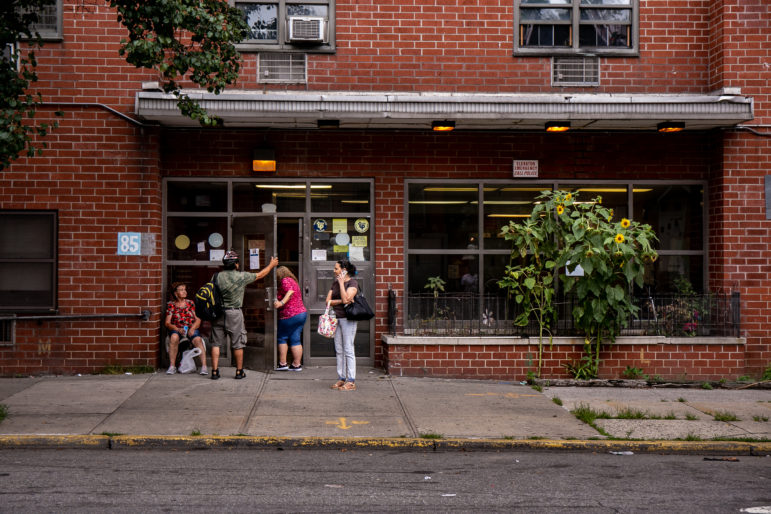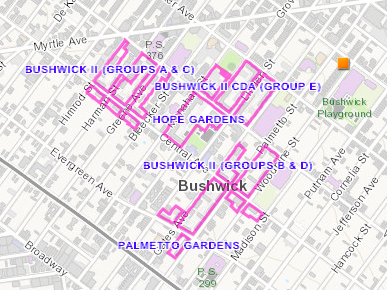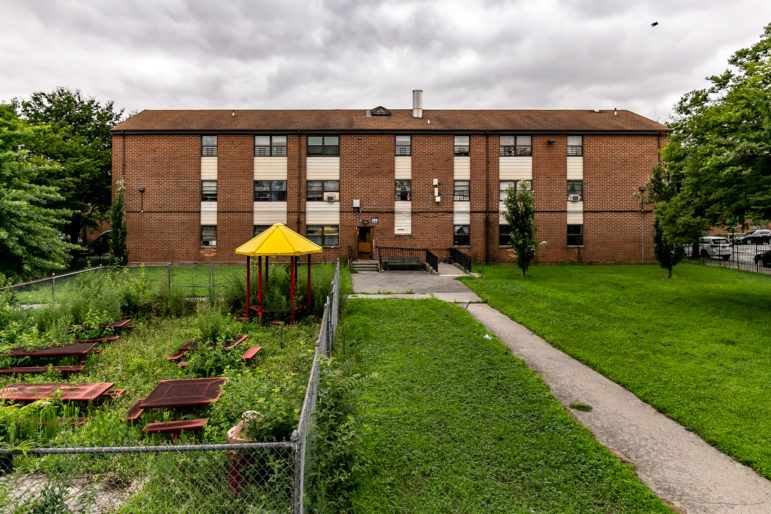
Adi Talwar
The Hope Gardens NYCHA development in Bushwick and the nearby developments that are managed as part of the same portfolio encompass 1,300 apartments housing 2,800 people.
* * * *
City Limits is in the midst of a month-long reporting project in Bushwick, revisiting a neighborhood on which we did an in-depth report 10 years ago. If you have a comment, critique or idea, please email us.
* * * *
The repairs will include complete kitchen and bathroom renovations, heating and plumbing systems upgrades, enhanced security systems, window replacements, and improvements of open spaces and common areas throughout the Hope Gardens housing complex. The renovation project is expected to be completed by 2021.
According to NYCHA, the renovations and improvements will be overseen by Pennsylvania-based Pennrose LLC. The Acacia Network, RiseBoro Community Partnership, the Coalition for Hispanic Family Services and the Bushwick United Housing Development Fund will serve as social-service providers.
The Hope Gardens public housing complex—which actually encompasses three separate NYCHA developments—does not look like a typical public-housing complex. It is unorthodox in design: While the actual Hope Gardens development has three high-rises, including a building for seniors, the nearby Bushwick II and Palmetto Gardens developments that are operated as part of Hope Gardens are comprised of low-density homes, three to four stories in height. The low-density units, better known to residents as townhouses or casitas, were created as part of a city and neighborhood collaboration to revitalize the area after Bushwick faced a decade of fiscal crisis and destruction, when properties were burned to the ground.
There is no question Hope Gardens needs substantial repairs. NYCHA’s latest physical assessment estimates more than $400 million in capital needs over the next 20 years, with more than $230 million in immediate needs. The Hope Gardens senior community center was closed last year for three months because of a severe rat infestation, according to seniors City Limits interviewed. “You could hear them in the ceiling,” said one senior. Some tenants, who did not want to named out of fear of losing their apartments, have told City Limits they have made several repairs themselves because they could not wait on NYCHA services to address issues, such as plumbing-related emergencies, in the past.
According to NYCHA tenants and local community groups, there are some concerns about the renovation project. The main concern has been the potential for tenant displacement from their units. There are also concerns about the details of the shift in project financing that will facilitate the work. And some stakeholders complain of a lack of communication from the housing authority, although NYCHA has said they have over 40 meetings with community groups over the last couple years in Bushwick.
And there are some questions about the future of social services at the site. The Wall Street Journal recently reported Acacia Network Housing, Inc. is under investigation by the city over allegations of undisclosed ties with a for-profit security firm. NYCHA would not comment on the allegations.

Adi Talwar
One of the townhouses, or casitas, that distinguishes parts of the Hope Gardens portfolio from many other NYCHA developments.
A shift in financing
The Hope Gardens housing complex renovations will be the sixth transaction under NYCHA’s Permanent Affordability Commitment Together (PACT) public and private partnership program, which is a key element in the housing authority’s plan to stabilize its finances and address a massive capital backlog. Under NYCHA’s NextGen 2.0 plan, which Mayor de Blasio unveiled in December 2018, some 62,000 units of the authority’s 174,000-apartment portfolio will be transferred to PACT.
PACT includes elements of the federal Rental Assistance Demonstration program (RAD), a Department of Housing and Urban Development tool created by the Obama Administration to strengthen the physical and financial state of public housing around the country. Under this program, major repairs are made after NYCHA shifts the federal subsidy supporting the development from the public-housing program (Section 9) to the Housing Choice Voucher Program, better known as Section 8.
According to NYCHA, approximately 1,164 new leases have been signed at Hope Gardens as part of the conversion from Section 9 to Section 8.
NYCHA says it will retain ownership of the buildings and the land while ensuring their private partners, who are leasing the land, adhere to HUD standards as stipulated in the contracts for PACT projects. Despite the shift from Section 9 to Section 8, the program will continue to guarantee residents pay no more than 30 percent of income on rent, have automatic lease renewal as long as they continue to meet the requirements to continue as a public housing tenant and enjoy succession rights. Tenants will also continue to have the right to establish and operate resident organizations recognized by NYCHA.
“Section 9, which is public housing, is funded year by year through the Congressional appropriation and budget process. So from one year to the next, technically, it has no assurance that the funding will continue over time,” says Victor Bach, Senior Housing Policy Analyst at Community Service Society of New York (a funder of City Limits). “So public housing is the least favorite of Congress’s housing programs and Section 8 is preferred.”

NYCHA
The elements of the Hope Gardens portfolio.
The Section 8 program is also funded year to year, but it’s a more favorable program to at least some Republicans and conservative Democrats in Congress since it subsidizes private owners of federally assisted housing rather than government-run housing authorities. Section 8 funding tends to increase with the costs of the market while public housing funding typically falls behind operating and capital costs over time.
Under RAD, operating money and capital funding are packaged together under a 20-year contract, which allows the site owners to borrow additional money. “That’s something that the owner can take to the bank and get financing for, because the lender or the investor will no longer be concerned about how stable the source of revenue is,” says Bach.
Furthermore, Bach says after the 20-year contract expires, under federal law, HUD is required to offer the owner a renewal of the contract and the owner is required to accept it. “So it’s truly an assurance of ongoing affordability, ongoing subsidy streams,” he says.
Change brings concerns
Community Board 4 Chair Robert Comacho and District Manager Celestina Leon say despite reaching out to NYCHA for the last six months, the first time they met with NYCHA formally was last month to discuss the upcoming renovations. “When we have things like this, for instance, we will reach out to them and say, ‘Hey, listen, this is affecting the entire district.’ So regardless of whether or not we always work together, we have to have some kind of public forum where you tell us what is going on, so that’s where we got into conversations recently with this transition team,” says Leon.
Leon says NYCHA and partnership representatives went into details including how NYCHA will deal with in-place renovations and what changes to expect. “We said to them, ‘You are doing something good, help us so we can help you,’” says Comacho. “This is part of the community board’s history with Hope Gardens.”
According to RiseBoro, tenant concerns included fear of losing their units to “right-sizing” (reducing the size of a unit when its tenant family has shrunk because children have aged into their own apartments), the loss of open space and security measures. For the larger Bushwick community, there were also concerns about public access to open-space areas, as well as feeling of lack of community inclusion in the process.
RiseBoro said in an email that the conversation with NYCHA is ongoing but felt the public housing agency has addressed most of the issues. The nonprofit said it planned to continue the engagement process with NYCHA community members and the larger Bushwick community “to ensure that the NYCHA campus and the residents’ voices were considered in the context of the proposed changes coming to Bushwick.”
“RiseBoro Community Partnership is rooted in Bushwick and is committed to helping the community thrive,” said Scott Short, RiseBoro’s CEO, in an emailed statement. “We welcome this significant investment in NYCHA, which will ensure the sustainability of critical affordable housing resources in Bushwick for current residents and future generations.”
In conversations with City Limits, some existing social-service providers employees on the site, who address senior needs such as breakfast or lunch meals or run educational workshops for NYCHA tenants, expressed concern about losing their employment in light of new social service providers coming in. According to NYCHA, all of the existing community-based services, including the Hope and Palmetto senior centers and the Head Start program, will remain in place. Additionally, the Acacia Network will establish an on-site social services program, with offerings ranging from referrals of community-based programs to education or training workshops, which will be funded at $263,000 annually.

Adi Talwar
Most of the Hope Gardens portfolio was built long after other public housing in the city. It was an effort to reclaim territory that had been scarred by fire and abandonment.
A multi-year process
There will be seven phases of the project. Some areas of the complex will see work start this year, while renovation of other sections will begin in 2020.
According to NYCHA, the PACT project will renovate all apartments and bathrooms and make modern improvements to buildings’ heating, ventilation and plumbing system. On the exterior, windows, entrances and roofs and landscaping will also see improvements. Lighting, cameras and intercom systems will see an overhaul.
The kitchen and bathroom renovation will vary by unit type; generally, the kitchen will see new vinyl floor tiles, replacement of doors and hardware, new windows and new A/C units. In the bathroom, there will be new vinyl floors, replacement of doors and hardware. The general cost for this work is approximately $62,000 per unit and all work is expected to be substantially completed by November 2021, according to NYCHA.
For the exterior, repair work and modernization efforts include roofing, window replacement, masonry and canopy repairs, entryway repair and replacement, exterior lighting, and the incorporation of roof mounted solar panels. An estimated hard cost is approximately $29 million.
The internal heating, ventilation and plumbing systems repairs include the replacement of boilers with new condensing boilers, installation of thermostat controls on radiators with WIFI monitoring for quicker responses, modernizing elevators, new electrical sub-panels, new lighting and rooftop fans, sewer backflow piping to stop back-ups, crawl space slab and venting to reduce odors and insulation to crawl spaces. The costs are estimated at $39 million and expected to be completed by 2021.
For sitework and landscaping, costs estimated at $13 million, repairs will include sidewalks, underground storm and sanitary piping and hardscape work. The work will be phased in to coincide with exterior building improvements. This also includes repairs and additions to existing landscaping, playgrounds and sports courts, and interior hardscaping areas.
The repairs for Hope Gardens Community Center include improvements made to lighting, plumbing and mechanical systems, the gymnasium and multipurpose space as well as replacing windows and the roofing. For security, lobby, elevator camera, door entry and exit alarms and key entrances will be upgraded.
The extent of the work raises the question of whether tenants will need to vacate their premises, and if so, for how long.
“We’ve got different developers approach the in-place rehabilitation differently. Some of them will work through it and do all the bathrooms on a certain day and then come back and do kitchens and on other days they will do the entire apartment in a whole day. The point is to try to minimize disruption and that has worked,” says Jonathan Gouveia, NYCHA’s Senior Vice President for Real Estate.
“Now there are certainly some cases where some apartments are more complicated than others. Maybe the condition of an apartment may be worse than others or maybe there are specific issues with the resident such as health issues. And so in those very minimal instances, they will be temporarily relocated while the renovation happens, but they are not displaced. The commitment is to avoid having people to stay out at a hotel for a couple of nights and, if it does have to happen, it is minimized as much as possible,” says Gouveia.
For those tenants who stay in their apartments all day, NYCHA says it will provide shared hospitality suites (empty apartments within the complex) for use while their units are under construction. Once construction is over, tenants will be allowed to return to their residence, the agency says. NYCHA says it would also provide financial assistance for out-of-pocket expenses associated with moves, and offer other services.
NYCHA said construction will begin 30 days after the closing of the deal and all households will receive a “Notice of Non-Displacement,” a “Thirty Day Notice” prior to construction, and weekly and daily notices leading up to construction.
Repairs aren’t the only change coming to public-housing territory in Bushwick. In March, NYCHA and the city’s Housing Preservation Development announced they were moving ahead with a 100 percent affordable senior housing development project named Linden Court which is slated to be constructed on Linden Street, between Knickerbocker and Wilson avenues on an empty publicly-owned lot. The developers Blue Sea Development Company and Gilbane Development Company proposed to develop a 13-story building with 154 senior units at one of the parcels that’s part of Bushwick II Houses, one of the developments that is considered part of Hope Gardens. Twenty-five percent of the units will be set aside for NYCHA residents and 30 percent of the apartments will be reserved for homeless seniors while NYCHA maintains ownership of the land. The project is slated to be completed by 2023.
The development will also include approximately 3,000 square feet of community facility, a senior center with an art gallery and café, warming kitchen, bathrooms, and two large multi-program rooms which can be divided to accommodate small classes and events. Social services will be provided by Jewish Association Serving the Aging (JASA), with additional programming provided by the Brooklyn Arts Council.
* * * *
| Development | Number of Buildings | Number of Apartments | Population | Date completed | Immediate Capital Needs | Total 20-year Capital Needs |
| Bushwick II (Groups A & C) | 25 | 300 | 743 | 1983 | $54,754,461 | $110,809,773 |
| Bushwick II (Groups B & D) | 25 | 300 | 728 | 1984 | $60,722,548 | $99,425,108 |
| Bushwick II CDA (Group E) | 5 | 276 | 542 | 1986 | $54,652,528 | $75,138,879 |
| Hope Gardens | 4 | 324 | 706 | 1981 | $46,525,009 | $95,466,082 |
| Palmetto Gardens | 1 | 115 | 118 | 1977 | $15,901,467 | $25,689,401 |
| TOTAL | 60 | 1315 | 2837 | $232,556,013 | $406,529,243 |
* * * *
[optin-monster-shortcode id=”jrapfmitogeenlyr5x7g”]









8 thoughts on “Facing Massive Repair Needs, Public Housing in Bushwick is Undergoing a Huge Shift”
Pingback: Facing Massive Repair Needs, Public Housing in Bushwick is Undergoing a Huge Shift – City Limits – Camas WA Plumbing Contractor Company
For $400m, you could built 1315 brand new units of housing EASILY!! How?? does it cost $62,000 to minimally upgrade an apartment. These are minimal upgrades… vinyl floors in the kitchen and bath… discount appliances… On what planet???
Thank you citylimits for finding and publishing the actual numbers.
Pingback: Inside Amazon’s grocery store playbook, rent strike emerges in Chelsea: Daily digest | ReallyList.com
Pingback: Inside Amazon’s grocery store playbook, rent strike emerges in Chelsea: Daily digest | Juspost NewsHub
Thank you for always keeping us informed. As a lifetime Bushwick resident i have seen first-hand the changes in Housing Authority maintenance and repair. Before the outsourcing/diminishing of the maintenance personnel, tenants could expect their building and floors to be swept, mopped and polished. Now the bare minimum is done. Elevators do not have air conditioning and are constantly breaking down. My mother( 77 yo) is in an apartment that has ceilings ready to fall on her, and flooding behind walls that have ruined her kitchen cabinets and walls. she is constantly awaiting repairs to no avail. She is afraid to leave her apartment overnight because there is potential of water/flood damage. I feel she has been institutionalized by the system.
Since this project came to be its been an disaster. The hallways are always dirty, piss fills the elevators, homeless sleeps in the stairways.. . My family resides in the tall complex of hope gardens its disgusting. They got us living like animals. Repairs are an job . Upgrade from what . Same cabinets n filmsy countertops that looks like marble paper on it to plastic bathroom walls .
The quality of work and materials is very poor. No appts are made. My apt has been flooded with mice and roaches since work began in December of 2020.
For $400m, you could built 1315 brand new units of housing EASILY!! How?? does it cost $62,000 to minimally upgrade an apartment. These are minimal upgrades… vinyl floors in the kitchen and bath… discount appliances… On what planet???
Thank you citylimits for finding and publishing the actual numbers.